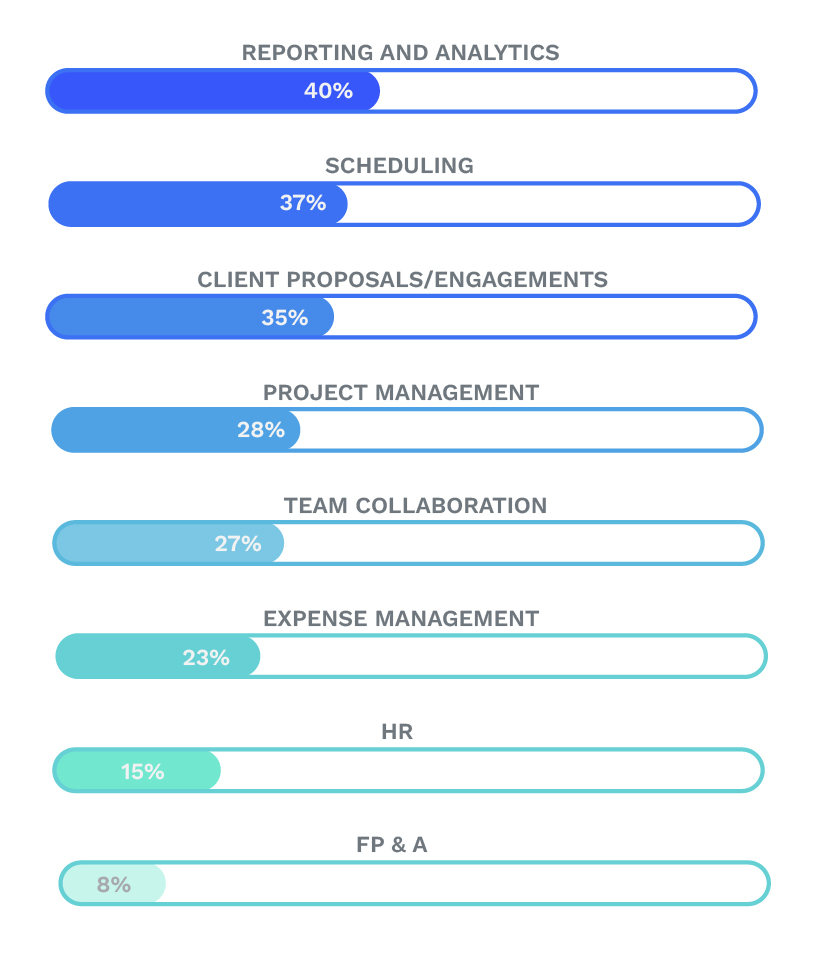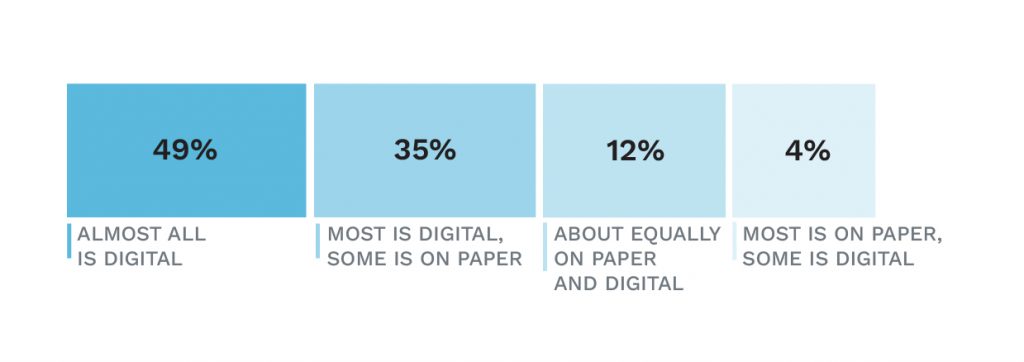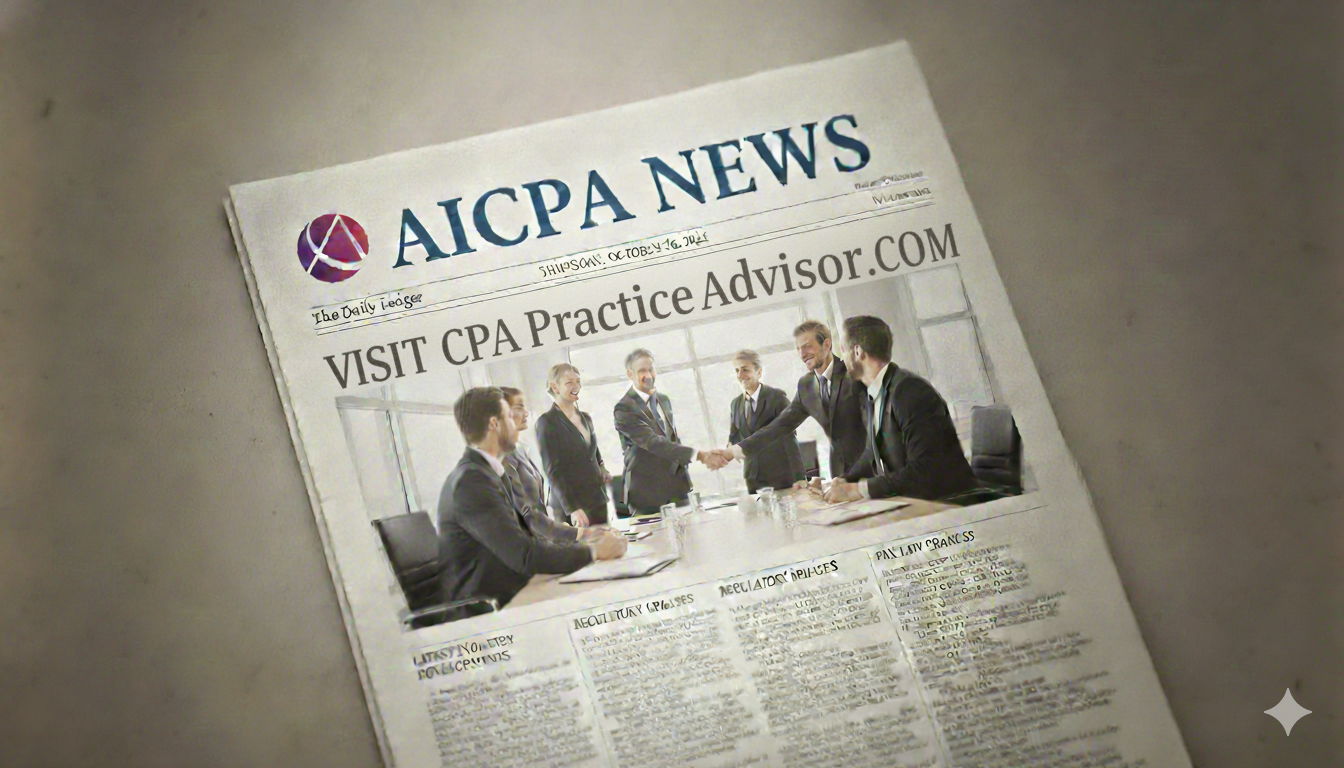By Chris Howard
Executive Summary
The accounting profession stands at the precipice of transformative change driven by rapid advancements in technology and evolving client expectations. This Canopy and CPA Practice Advisor survey asked respondents to share where they currently were and where they thought their firms would be three to five years from now on topics like automation, AI integration, workforce dynamics, remote work models, client interaction, digital transformation, security and more. The surveys key findings were:
AI Integration
- 80% anticipate using more AI, with significant growth expected in areas such as accounting work, data analysis, and client communication.
Technology Usage and Satisfaction
- A high level of satisfaction (87%) with current tech stacks suggests that firms are generally content with their technological tools.
- Tax preparation software, client portals, and general ledger systems are identified as the most important tools, indicating a focus on core accounting functions.
Digital Transformation
- 66% of firms conduct most of their business digitally, and this is expected to rise to 84% in the next three years.
- The move toward digital operations is driven by the need for greater efficiency, accuracy, and security.
Security Concerns
- 99% of respondents consider online security important, with a focus on protecting sensitive client information and mitigating risks.
- Despite a strong emphasis on security, 15% of firms have experienced a breach, highlighting the ongoing challenges in this area.
Client Interaction
- On average, respondents spend 9.3 hours per week on client communication, with a target to reduce this to 7.2 hours through more efficient practices.
- Digital tools, such as client portals and video conferencing, are poised to play a crucial role in optimizing client interactions.
Workforce Dynamics and Automation
- A significant wave of retirements are anticipated, with 20% of respondents expecting that 51% or more of their CPAs will retire within the next three years.
- 57% of respondents expect more work to be automated in the next five years, signaling a shift toward increased efficiency and productivity.
- 67% of firms plan to hire new employees, with a strong focus on adapting to the impending demographic changes in the workforce.
Remote and Hybrid Work Models
- 67% of firms currently offer remote or hybrid work options, with 35% planning to increase these options in the future.
- The shift toward flexible work models is expected to continue, emphasizing the need for robust digital infrastructure and management practices.
Survey Report
AI Integration
The survey data highlights the current and anticipated future use of Artificial Intelligence (AI) within accounting firms. Presently, AI adoption is still in its early stages, with 52% of respondents indicating they are not using AI for any purposes. Among those who are leveraging AI, the most common applications include writing (34%), which covers tasks like email and content creation, followed by accounting work (14%), reporting and analysis (12%), data entry (12%), and document analysis (12%). A smaller percentage are using AI for creating tasks (7%) or other unspecified functions (8%).

Looking ahead, there is a strong expectation that AI usage will increase significantly within the industry. Eighty percent of respondents believe they will use more AI in the next 3-5 years, with 38% expecting to use much more and 42% anticipating somewhat more AI integration. Meanwhile, 15% expect their AI usage to remain the same, and only 5% foresee using less AI. This data suggests a growing recognition of the potential benefits of AI in enhancing efficiency, accuracy, and productivity in various aspects of accounting work, with a clear trend toward greater adoption in the near future.
Future Use of AI

Overview of the Accounting Profession
The survey data reveals a generally positive sentiment among respondents regarding their current work environments, with 90% expressing satisfaction in their roles. A notable 61% of respondents are very satisfied with their current organization, highlighting a strong sense of contentment in their professional settings. This high level of workplace satisfaction suggests that many accounting professionals find their employers supportive and conducive to their career goals, which could be a key factor in employee retention and overall job satisfaction within the industry.
Assessing Satisfaction with Accounting

The data also uncovers some underlying concerns about the broader accounting profession and its future. While 63% of respondents are satisfied with the current state of the accounting profession, only 15% report being very satisfied, indicating that nearly half of those satisfied might still see room for improvement. Additionally, 37% are not satisfied with the profession as it stands, reflecting a significant portion of the workforce that feels the industry could better meet their expectations or needs. Looking ahead, 70% of respondents feel satisfied with what the future holds for accounting, yet a noteworthy 30% remain dissatisfied. This mixed outlook on the future suggests that while there is optimism, there are also concerns that may need to be addressed, such as adapting to technological advancements or navigating regulatory changes.
These takeaways point to a profession that, while currently stable and rewarding for many, faces challenges that could affect its future trajectory. Addressing these concerns and enhancing the aspects of the profession that contribute to satisfaction will be critical in maintaining a positive outlook among accounting professionals.
Accounting Tools and Utilization
The survey data on the use of accounting software and technology reveals interesting insights into how professionals in the field currently operate and their future preferences. Currently, the majority of respondents are using a relatively small number of tools to manage their business operations, with 45% utilizing between 1-5 tools. This suggests that many accounting professionals prefer to keep their software ecosystems streamlined, possibly to avoid complexity and reduce the learning curve associated with multiple tools. However, a significant portion, 40%, are using between 6-10 tools, indicating that a sizable group is already embracing a more diversified approach to technology. Smaller percentages, 10% and 3% respectively, are using between 11-15 tools and over 20 tools, suggesting that some firms are leveraging a wide range of software solutions to meet their operational needs.
Assessing Satisfaction with Accounting Tech Stacks

Looking ahead, there is a clear trend toward increasing the number of software tools used in the future. Fifty-seven percent of respondents would like to be using between 1-5 tools three years from now, indicating a desire to enhance efficiency and accuracy by consolidating software. This shift suggests that accounting professionals are recognizing the value of cross-functional tools that streamline their workflows. Interestingly, only 29% of respondents wish to use 6-10 tools. The small percentages, 7% wanting 11-15 tools and 3% aiming for 16-20 tools, further illustrate the shift toward simpler software ecosystems.
These findings highlight a growing acceptance and reliance on technology within the accounting profession, with a clear shift toward consolidating the use of software tools in the coming years. This could reflect the increasing demands for efficiency, accuracy, and comprehensive client management solutions, as well as the need to stay competitive in an evolving digital landscape.
The survey data on the technology tools currently in use by accounting professionals reveals a strong reliance on essential software solutions, with a few tools emerging as nearly ubiquitous across organizations. Eighty-eight percent of respondents report using tax preparation software, making it the most commonly used tool, which is unsurprising given the critical nature of tax-related services in accounting. Similarly, 71% use document storage solutions, and 70% rely on general ledger software, underscoring the importance of maintaining accurate and accessible records in the profession.
Software Utilization in Accounting Firms: Current Tools and Future Needs

Other key tools widely adopted include payroll software (69%), client portals (64%), and eSignatures (57%). These tools are fundamental in managing day-to-day operations, client interactions, and secure document handling, highlighting the industry’s focus on efficiency and client service. Additionally, 57% of respondents use payment processing systems, and 54% have integrated CRM and email tools as well as time tracking software into their operations, reflecting a broad need for tools that support client management and accurate billing.
However, some tools, while still important, are less commonly used. Practice management software is used by 46% of respondents, and reporting and analytics tools by 40%, suggesting that while many firms recognize the value of these tools, there is still room for broader adoption. Tools like scheduling (37%), client proposals/engagements (35%), and project management (28%) are also less prevalent, potentially indicating a focus on core accounting functions over auxiliary operations.
Software Utilization in Accounting Firms: Current Tools and Future Needs (Part 2)

Assessing Importance of Firm Tech Stack

Digital Transformation
The survey data on the digital transformation of accounting practices reveals a significant shift toward digitalization, with the majority of firms already operating predominantly in digital environments. Currently, 66% of respondents report that their business operations are all or mostly digital, with 33% indicating that almost all their work is digital and 34% using a mix of digital and paper processes. This trend underscores the profession’s growing reliance on digital tools and platforms to manage day-to-day tasks, improve efficiency, and enhance accuracy. However, a notable 24% of respondents still operate with a balance between digital and paper processes, and 10% remain heavily reliant on paper, suggesting that while digitalization is widespread, there are still pockets within the industry where traditional methods persist.
Digital vs. Paper: The Future of Document Management in Accounting

Looking ahead, the data suggests an even stronger move toward digital operations in the near future. 84% of respondents believe their organizations will be all or mostly digital within the next three years, with nearly half (49%) expecting that almost all their work will be digital. This anticipated increase reflects a growing confidence in digital tools and a recognition of their benefits, such as enhanced efficiency, better client engagement, and streamlined workflows. The percentage of firms expecting to maintain an equal balance between paper and digital is projected to decrease to 12%, while those anticipating a predominantly paper-based operation drops to a mere 4%.
Future of Digital vs. Paper

This narrative indicates a clear trajectory toward digital dominance in the accounting industry, driven by the need to stay competitive, meet client expectations, and optimize operations. The data highlights both the progress made in digital adoption and the future potential for further transformation, positioning digital tools as central to the evolution of the profession. As firms continue to transition, the move away from paper-based processes appears to be an industry-wide priority, signaling a future where digital-first approaches become the standard in accounting practices.
Security Concerns
The importance of online security within the accounting profession is universally recognized, with 99% of respondents identifying it as important to their organization, and a significant 92% stating it is very important. Looking ahead, this priority is expected to remain high, with 98% of respondents believing online security will be important in the next three years, and 94% anticipating it will be very important. This consistent emphasis on security highlights the profession’s awareness of the critical need to protect sensitive financial data and maintain client trust in an increasingly digital landscape.
Importance of Online Security for Accounting Firms (Present/Future)

Despite this strong focus on security, 15% of respondents have experienced a security breach, illustrating that vulnerabilities still exist. The most common cause of breaches was clicking the wrong link (26%), pointing to the ongoing threat of phishing attacks. Other significant causes included ransomware (14%), service provider issues (9%), cloud server hacks (9%), and the theft of computers or data (9%). These incidents underscore the diverse nature of cybersecurity risks, ranging from user errors to sophisticated external attacks.
Accountants Who’ve Experienced a Security Breach

The financial impact of these breaches varies, with 29% of those affected costs of less than $100,000. However, some breaches have been more costly, with 11% of respondents experiencing losses between $500,000 and $999,999, and 3% reporting losses exceeding $5 million. Additionally, 17% of respondents indicated that while their breach did not result in direct financial loss, it caused significant reputational damage—an equally serious consequence in a profession that relies heavily on trust and credibility.
Security Breaches in Accounting Firms: Causes, Costs, and Consequences

In addition to the critical importance placed on online security, the survey reveals a nearly even split in practices regarding the handling of sensitive client information. Forty-nine percent of respondents allow clients to email sensitive information, such as tax forms, to their firm, while 51% do not permit this practice. This divide highlights differing approaches to balancing convenience and security in client communications. Firms that allow the emailing of sensitive information may prioritize ease of access for clients, but this practice could also expose them to increased risk if not properly managed. On the other hand, those that prohibit such emails likely do so to minimize the risk of data breaches, reflecting a more cautious approach to handling sensitive information. This split underscores the varying levels of risk tolerance within the industry and the ongoing challenge of protecting client data while maintaining efficient communication channels.
Cost of the Data Breach

Together, these insights emphasize the need for firms to carefully consider their cybersecurity policies and practices, particularly in relation to client communications, as part of their broader strategy to safeguard against potential breaches and their consequences.
Client Interaction
The survey data reveals key insights into how accounting professionals manage client communications, the time invested, and the tools used for these interactions. A significant portion of respondents, 49%, typically spend 1-2 days communicating with clients to gather all necessary information for a typical engagement, while 36% spend 3-7 days. However, 16% of respondents report spending two weeks or more on this process, highlighting variability in the efficiency of client interactions.
Time Spent Communicating with Clients

When asked about their satisfaction with the time spent on client communications, 51% believe they spend about the right amount of time, while 18% feel they spend too much time, and 30% think they don’t spend enough time. This indicates a range of perspectives, with a notable portion of professionals seeking to optimize the time dedicated to client interactions.
Too Much or Too Little Time

Looking ahead, opinions on future time allocation are divided. Thirty-seven percent of respondents expect to spend more time with clients over the next three years, with 9% anticipating a significant increase. Meanwhile, another 37% expect their client time to remain the same, and 26% believe they will spend less time with clients, reflecting a trend toward potential efficiency gains or shifts in communication methods.
Currently, email dominates client communication, accounting for 35.4% of the time spent on average, followed by in-person meetings (16.8%) and business desk phone calls (11.3%). Looking to the future, 64% of respondents expect email to remain the most-used communication tool, with 37% predicting an increased reliance on client portals and 30% on video conferencing. This shift suggests a move toward more digital and remote communication methods, likely driven by convenience and efficiency.
Time Spent Communicating with Clients: Current and Future Expectations

In terms of communication style, 39% of respondents describe their interactions as mostly proactive, while another 39% see it as equally proactive and reactive. 22% report that their communication is mostly reactive, indicating that a significant portion of client interactions are still driven by client-initiated requests or issues.
Proactive vs. Reactive Communication: Strategies in Accounting Firms

Overall, the data reflects a profession in transition, with ongoing efforts to balance the time spent on client communications with the need for efficiency and the adoption of more digital communication tools. As accounting professionals look to the future, there is a clear trend toward increasing digitalization and potentially more strategic, proactive client engagement.
Workforce Dynamics
The survey data provides insights into the anticipated workforce changes in accounting firms over the next three years, focusing on CPA retirements and hiring plans. Regarding retirement, 37% of respondents believe that none of their CPAs will retire within the next three years. However, a significant portion of firms expect a notable level of turnover, with 20% anticipating that more than half of their CPAs will retire, and the average expected retirement rate across firms is 30.5%. This suggests that many firms are bracing for substantial changes in their workforce due to retirements.
Number of Accountants Retiring in 3 Years

In response to this anticipated turnover and potentially to support growth, 67% of firms plan to hire new employees in the next three years, with 37% definitely planning to do so and 30% likely to hire. On the other hand, 33% of respondents indicated that they do not plan to hire, reflecting a divide in how firms are approaching future staffing needs. This data highlights the dual challenge of managing retirements and planning for growth or replacement within the accounting profession over the near term.
Assessing Workforce Expansion and Firm Growth in the Next 3 Years

Future of Automated Accounting

As the accounting industry continues to evolve, professionals are anticipating significant changes in the organizational structure of firms over the next five years. According to survey data, 57% of respondents believe that more work will be automated, signaling a trend toward the integration of advanced technologies such as AI and machine learning. Automation is expected to take over repetitive and routine tasks, allowing accountants to focus more on strategic decision-making and client advisory roles. This shift emphasizes the growing importance of technology in shaping the future of the profession.
Additionally, 39% of respondents predict that more work will be done by non-CPAs, reflecting a shift toward a broader range of professionals, such as data analysts and consultants, contributing to firm operations. Furthermore, 18% believe that administrative staff will take on more non-technical tasks, indicating a potential redistribution of roles within firms. However, 15% of respondents think the structure of their organization will not change, suggesting that while some firms will embrace these shifts, others may remain more traditional in their approach.
Remote and Hybrid Work Models
The survey data reveals that a significant majority of accounting firms currently offer remote and/or hybrid work options to their employees. Sixty-seven percent of respondents indicate that their organizations provide these options, with 42% offering them to all employees and 25% offering them to some employees. Meanwhile, 33% of firms do not offer any remote or hybrid work options, reflecting a segment of the industry that remains committed to traditional, in-office work arrangements.
Current Remote/Hybrid Offerings

Looking ahead three years, the trend toward remote and hybrid work appears likely to continue, with 35% of respondents expecting to offer more remote or hybrid options. However, the majority (53%) anticipate that their remote/hybrid options will remain the same, indicating a stabilization of current policies. Only 12% of firms expect to reduce these options, suggesting that while some firms may revert to more traditional work models, the overall industry trend favors maintaining or expanding flexible work arrangements.
Forecasting Changes in Remote/Hybrid Work Over the Next 3 Years

Future Outlook
The future of accounting is characterized by a significant shift toward automation and AI, which are expected to transform traditional practices and enhance productivity. Firms will need to adapt to changing workforce dynamics, including the retirement of experienced CPAs and the integration of new talent. Remote and hybrid work models will become increasingly common, necessitating the development of effective digital communication and collaboration tools.
Digital transformation will continue to be a critical driver of change, with firms increasingly relying on cloud-based solutions and digital workflows to streamline operations. Security will remain a top priority, requiring ongoing investment in robust protective measures to safeguard sensitive data.
The accounting profession is on the brink of substantial change. By embracing new technologies, adapting to workforce shifts, and prioritizing digital and security initiatives, accounting firms can position themselves for success in the evolving landscape. This report provides actionable insights and recommendations to help firms navigate these changes and thrive in the future.
Methodology
The survey was conducted for Canopy and CPA Practice Advisor in June 2024 and includes responses from 240 accounting professionals.
About Canopy
Canopy’s firm-wide operating system provides a modern, cloud-based platform that brings live updates to your systems when needed. With a customizable suite entirely based on the needs of your firm, Canopy unlocks the path to success through industry-leading practice management software.
About CPA Practice Advisor
CPA Practice Advisor is a trusted resource for accounting and tax professionals, offering the latest industry news, technology insights, and best practices. Dedicated to helping CPAs stay ahead in a fast-paced industry, it provides comprehensive software reviews, thought leadership articles, and educational content through webinars and podcasts. By empowering firms to embrace new technologies, improve client engagement, and navigate regulatory changes, CPA Practice Advisor plays a vital role in supporting the growth and innovation of the accounting profession.
ABOUT THE AUTHOR:
Chris Howard is a content manager for Canopy, joining the team with a combined eight years of experience as a copywriter, editor-in-chief, and content marketer. He’s a skilled wordsmith and strategic thinker who shapes brand identity through compelling content and fosters a collaborative and innovative environment. With a passion for storytelling and a dedication to excellence, he is a driving force behind any company’s success in content marketing. Champion of the Oxford comma.
Thanks for reading CPA Practice Advisor!
Subscribe Already registered? Log In
Need more information? Read the FAQs




